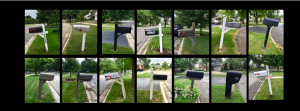The other day while walking my dog I noticed a mailbox leaning toward the street. As I continued the walk, I suddenly became aware that about 1/3 of the mailboxes on our route were leaning.
We’ve lived in our house for nearly twenty years.
I’m pretty sure that when we moved in, most mailboxes stood straight and tall.
Back then, I bet more people would have taken notice of something so seemingly trivial. In fact, my guess is that some of the neighbors would have provided subtle hints to the homeowner that it was time to literally “straighten up”.
So, what’s caused this odd trend? It’s simple. A trade-off between good and cheap or efficient.
In the “old” days, people installed mailbox posts in a two-foot hole filled with concrete. Those posts weren’t going anywhere. Of course, when the post eventually wore down or if it was somehow damaged, replacing it was a pain. The owner had dig out this giant, heavy cylinder of concrete. Then he or she had to figure out what to do with it.
Enter the mailbox spike. This wonderful invention consists of a heavy two-foot spike with a mounting bracket on top. The spike is driven into the ground and the post is secured to the bracket.
It’s a lot easier to use. It’s easier to install. It’s easier to replace. It’s cheaper. It’s just easier.
And, it works pretty well – at least at first.
However, a spike is no match for concrete. Eventually due the ground settling, rain and snow loosening the dirt, and other pressures placed upon the post, the mailbox begins to lean.
I suspect that people are willing to accept a little “lean” for the added convenience. And, over time, the neighborhood begins to accept a lot of lean for that same convenience.
But not everyone benefits from this new solution. I’ve seen some posts that are leaning so far over that watching the mail carrier deliver mail is like attending Cirque du Soleil. One person’s ideal solution might be someone else’s nightmare. Often that “someone” is your customer or employee.
So, what do leaning mailboxes have to do with business or leadership?
I see the same thing happening in business. For the sake of savings or “efficiency”, we’ve lost sight of what “good” looks like.
Some technologies, processes, and business models improve efficiency, decrease costs, and create a better customer or employee experience. These are the ones that disrupt or revolutionize industries.
However, many don’t. In fact, companies are often forced to make a trade-off between cost, efficiency, and customer/employee experience.
Sadly, cost and “efficiency” often win.
What are the “leaning mailboxes” in your business?
What customer or employee experiences do you provide that ten or fifteen years ago would have been considered unacceptable?
Think about your own experiences as a customer or employee.
Do you find it harder to get issues resolved on the first try? Do you find it hard to even find the right person to resolve your issue (or someone who feels empowered enough or accountable enough to resolve your issue)? Are service associates in stores as helpful and knowledgeable as they once were? Are your virtual meetings or virtual training experiences as good as your old meeting and training experiences? Are you getting the same quality products and services as before? Do companies and restaurants get your orders correct on the first try? When they don’t, is it easy to get the problem resolved?
My personal experience as well as the stories I hear from others is that despite some notable exceptions, doing business is much harder than it used to be. Executing transactions might be easier, but what comes before and what comes after those transactions isn’t as friendly as it once was. This is especially true when things don’t go right on the first try. It seems like much of our automation, technology, and process design assumes things will work. There seems to be way less focus on what happens when they don’t.
My son is currently on his fourth day trying to purchase a computer from Apple. He had a minor issue with his credit card on the first attempt to make payment. This has turned into a process requiring multiple calls and on-line “chats” with Apple and his bank. He’s even tried cancelling and re-ordering. As of today, he still has no idea whether the order has gone through. Four days just to make a purchase.
I know you have a version of this story as well. It might not be with Apple or for a computer purchase, but we’ve all experienced the steady decline of customer or employee experience.
Despite this, I see companies brag about their Net Promoter Scores, quality initiatives, JD Powers rankings, and other measures of customer experience.
But I wonder. Do those scores really reflect good service? Or, have we just conditioned people to accept poor service.
It’s sort of like the mailboxes. If we compared a survey on neighborhood aesthetics now with one from ten years ago, I bet the results would be similar. It’s not that the neighborhood looks as good. It’s just that we’ve gotten used to those leaning mailboxes.
Take a look at your customer and employee experience. Ask yourself one simple question, “Would this have been acceptable ten years ago?” If the answer is “no”, then perhaps those cost or efficiency savings you are getting aren’t really worth it.
—————–
Brad Kolar is an executive consultant, author, and speaker with Avail Advisors. Avail helps leaders simplify their problems, decisions, data, and communication. He can be reached at Brad.Kolar@availadvisors.com.


